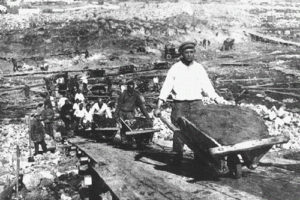Growth of Public History in Russia ‘Democratizing Memory,’ New Study Says

(Paul Goble – Window on Eurasia – Staunton, January 17, 2019)
[Text with links windowoneurasia2.blogspot.com/2019/01/growth-of-public-history-in-russia.html]
Public history, the trend within the history discipline in many places around the world that seeks to rely on the digitalization of personal memoirs, diaries, and photographs of ordinary people to present the past from below, has come to Russia and is “democratizing memory” in that country, according to a new study.
Yekaterina Lapina-Kratasyuk and Milena Rubleva of the Higher School of Economics have explored how such materials are affecting what they call “the culture of participation” (“Preservation Projects of Personal Memory” in Russian, Shagi, 4:3-4(2018): 147-168 at publications.hse.ru/articles/221903234; summarized at iq.hse.ru/news/231962189.html).
They considered ten of the most-visited online digital archives that have assembled materials about the main tragedies of Russia in the 20th century – the revolution, Stalinism and mass repressions – to explore the ways this history from below challenges the various and changing official narratives from above.
Most of these digital archives are separate from the state in another way: they are the work of volunteers and raise money for themselves by crowd-sourcing. As such, they destroy the monopoly on such history formerly enjoyed by the state and professional histories and encourage people to view the past through their own lives rather than through what they are taught.
They are extremely diverse. Among them are collections of interviews (“Oral History”), personal diaries (“What I lived through”), family histories (“Siberians Free and Unfree”), virtual museums (“European Memory about the GULAG”), photographs (“PastVu” and “History of Russia in Photographs”), martyrologies, and others.
Like almost everything else in Russia, these are highly centralized: nine of the ten they examined are based in Moscow; only one beyond the ring road. It is in Tomsk. Unfortunately, the two investigators relate, local history is as yet less often the object of attention by Russian digital history.
Many of these archives are based in universities and government archives, but because of the way they are financed and the nature of the people behind them, the scholars continue, they are “privatizing history,” “democratizing memory,” and allowing for the appearance of a research-backed “alternative memory” of key events.
They are also integrating these popular projects directly into international cooperation efforts such as Le Centre d’études des mondes russe, caucasien et centre-européen at https://www.cercec.fr/ and Radio France International.
The sites they examined include:
Oral History at http://oralhistory.ru/
What I have lived Through at prozhito.org/
European Memory about the GULAG at museum.gulagmemories.eu/
The Obninsk Digital Project at obninsk-project.net/
Siberians Free and Unfree at сибиряки.онлайн/
PastView at pastvu.com/
Reliquary at relikva.com/
The Immortal Barracks at https://bessmertnybarak.ru/
